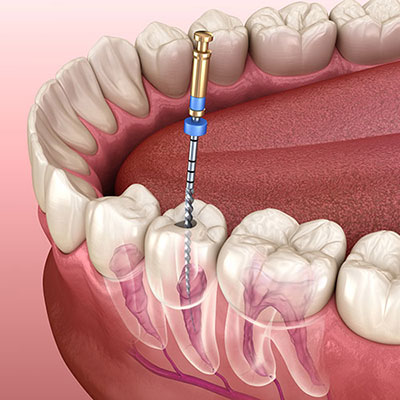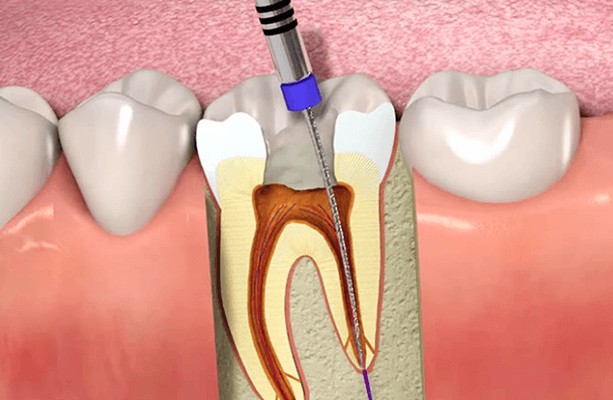Root Canals
If just hearing the words ‘root canal’ sends a shiver down your spine, trust us, you’re not the only one. But here’s the good news: modern root canals are nothing like the painful ordeals of the past. In fact, with today’s advanced techniques, they’re often no more uncomfortable than getting a simple filling. Root canals aren’t just about saving your smile they’re about preserving your natural teeth, protecting your health, and helping you avoid bigger (and far more painful) problems down the line.

Understanding Treatment
At its core, a root canal (officially called endodontic therapy) is a procedure designed to save a severely damaged or infected tooth. When tooth decay or injury reaches the inner pulp — the soft tissue containing nerves and blood vessels — it can cause intense pain, infection, and even abscesses. Without treatment, you could lose the tooth altogether. A root canal steps in to clean out the infection, remove the damaged pulp, and seal the tooth so you can keep it healthy and functional. It’s less about punishment and more about rescue.
The Root Canal Procedure: Step-by-Step
If you’ve ever wondered what really happens during a root canal, here’s a quick look behind the curtain:
- Diagnosis: Your dentist uses X-rays to zero in on the source and severity of the problem.
- Local Anesthesia: You’re thoroughly numbed — trust us, you won’t feel a thing.
- Isolation (Rubber Dam): A protective barrier keeps the tooth dry and free from saliva.
- Access Opening: A small opening is made in the crown of the tooth to reach the pulp chamber.
- Pulp (Nerve) Removal: Your dentist carefully clears out the inflamed or infected pulp to protect the tooth.
- Cleaning and Shaping: Tiny instruments clean and shape the root canals for filling.
- Irrigation: The canals are flushed with antibacterial solutions to clear out any lingering debris.
- Filling Canals: The empty canals are filled with a biocompatible material called gutta-percha.
- Sealing the Opening: To protect your newly treated tooth, your dentist places a temporary or permanent filling over the opening.
- Follow-Up Appointments: Often, a crown is placed later to fully restore strength and appearance.
Thanks to modern root canal techniques, this whole process usually takes between 60 and 90 minutes quicker than most people expect.
Risks and Complications
Like any medical procedure, root canals come with some potential risks. These can include infection, fracture of dental instruments inside the canal, minor perforations, or post-procedure discomfort. But here’s the truth: serious complications are rare, especially when you follow your dentist’s aftercare instructions. Good oral hygiene, brushing, flossing, and regular check-ups dramatically reduce your risk of problems after treatment.
Root Canals with Existing Crowns or Fillings
Already have a crown or a large filling? You can still need a root canal. Sometimes decay sneaks under old restorations or cracks form, allowing bacteria to reach the pulp. In these cases, your dentist can perform a root canal through the existing crown or recommend a replacement afterward. This is why routine dental visits are so critical, they catch little problems before they turn into major ones.
Best Dentists in Washington & Oregon
Duration of a Root Canal Procedure
Most straightforward root canals can be wrapped up in a single appointment lasting about an hour to an hour and a half. Complex cases (like back molars with multiple canals) might need a second visit. Factors like the severity of the infection, tooth location, and the number of roots involved can all influence timing. But overall, the process is faster and easier than most people imagine.
When a Root Canal is Delayed or Avoided
Delaying a needed root canal is where the real danger lies. Left untreated, a tooth infection can lead to worsening pain, swelling, bone loss around the tooth, and in severe cases, systemic health issues. You might even end up needing a full extraction, which brings a whole new set of challenges. Getting a root canal promptly keeps things simple, preserves your natural tooth, and prevents larger (and costlier) problems down the road.
Post-Procedure Care and Healing
Root canal aftercare is crucial for smooth healing. After your procedure, follow your dentist’s instructions carefully. You might experience some mild tenderness for a few days think soreness, not sharp pain , but over-the-counter pain relievers usually handle it easily. Keep up with gentle brushing and flossing, avoid chewing hard foods on the treated side until your permanent crown is placed, and watch for any unusual symptoms like swelling or persistent discomfort.
Also, don’t skip your follow-up visit; finishing the tooth’s restoration (usually with a crown) is essential for long-term success. Fixing the tooth is just the beginning; how you care for it afterward determines how long it lasts.
Root canals have come a long, long way. Thanks to modern advances, they’re faster, more comfortable, and incredibly effective at saving natural teeth. If you’re dealing with a toothache, swelling, or signs of infection, don’t let fear keep you from seeking care. Early action means easier treatment and a better outcome for your smile and your overall health.
Your teeth were meant to last a lifetime. Root canals help make sure they do.

